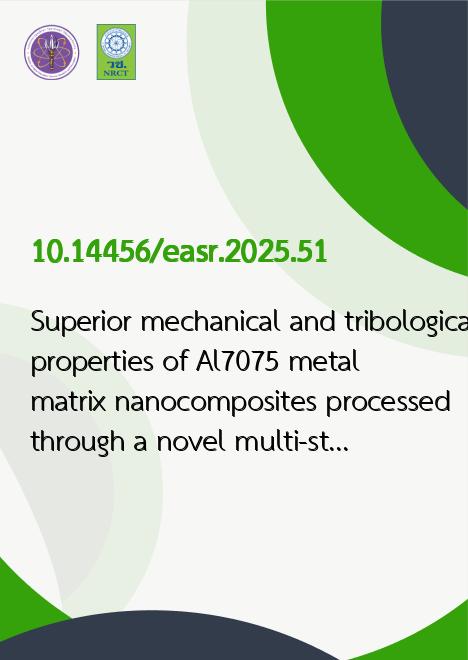
|
Superior mechanical and tribological properties of Al7075 metal matrix nanocomposites processed through a novel multi-stage casting route |
|---|---|
| รหัสดีโอไอ | |
| Creator | Sukangkana Talangkun |
| Title | Superior mechanical and tribological properties of Al7075 metal matrix nanocomposites processed through a novel multi-stage casting route |
| Contributor | Charinrat Potisawang, Kowit Ponhan |
| Publisher | Faculty of Engineering, Khon Kaen University |
| Publication Year | 2568 |
| Journal Title | Engineering and Applied Science Research |
| Journal Vol. | 52 |
| Journal No. | 6 |
| Page no. | 560-571 |
| Keyword | Al7075 Nanocomposite, SiC Nanoparticles, T6 Heat treatment, Mechanical properties |
| URL Website | https://ph01.tci-thaijo.org/index.php/easr/index |
| Website title | Engineering and Applied Science Research |
| ISSN | 2539-6161 |
| Abstract | This study aims to improve the microstructural features and mechanical performance of Al7075 aluminium matrix composites reinforced with silicon carbide (SiC) nanoparticles and graphite (Gr) through a novel processing route. The proposed method integrates mechanical alloying-assisted semisolid stir casting with die casting, followed by a T6 heat treatment. The Al7075/SiC composite subjected to T6 treatment exhibited superior mechanical properties, including a microhardness of 218 HV, a 0.2% proof stress of 250 MPa, an ultimate tensile strength of 364 MPa, and an elongation of 16%. These enhancements are primarily attributed to synergistic strengthening mechanisms, including grain refinement, Orowan looping, and precipitation hardening. In contrast, the Al7075/SiC/Gr hybrid composite demonstrated a marginally reduced ultimate tensile strength of 254 MPa, representing a 12% decline compared to the Al7075/SiC composite, which was attributed to graphite agglomeration and inadequate interfacial bonding. Wear resistance testing revealed that the SiC-reinforced composite exhibited the lowest material loss, with scanning electron microscopy (SEM) analyses confirming reduced groove depth and plastic deformation. Conversely, the hybrid composite displayed increased surface roughness and porosity, primarily due to graphite-induced defects. These findings indicate that the incorporation of SiC nanoparticles, in conjunction with T6 heat treatment, constitutes an effective strategy for enhancing the structural integrity and mechanical performance of Al7075-based composites. However, further optimization of graphite morphology and dispersion is necessary to fully realize its potential as a solid lubricant in hybrid composite systems. |